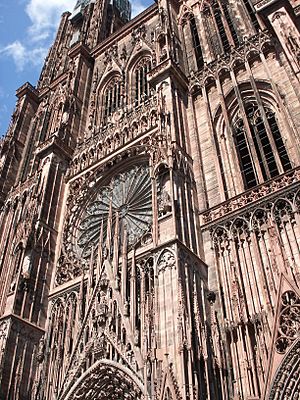Facade facts for kids

A facade (pronounced "fah-SAHD") is usually the outside front of a building. It's like the "face" of the building. Sometimes, the word can also mean the sides or back of a building. The word comes from the French language and literally means "frontage" or "face."
The facade is very important because it's the first thing people see. It often shows off the building's style and purpose.
Contents
What is a Facade?
A facade is the main outer wall of a building. It's designed to be attractive and welcoming. Think of it as the building's public appearance. Architects spend a lot of time designing facades. They want them to look good and fit with the building's overall style.
The facade also protects the inside of the building. It keeps out weather like rain, wind, and sun. It can also help control the temperature inside.
Why Facades are Important
Facades do more than just look pretty. They tell a story about the building and its time period.
- First Impression: The facade is the first thing you notice. It sets the mood for the whole building.
- Architectural Style: Facades show off different building styles. You can often tell if a building is old or new just by looking at its facade.
- History: Many famous facades have historical importance. They can be hundreds of years old.
- Function: Beyond looks, facades protect the building. They can also let in light or provide privacy.
Different Styles of Facades
Facades have changed a lot throughout history. Different time periods had their own popular styles.
Classical Facades
Classical facades are inspired by ancient Greece and Rome. They often feature columns, arches, and balanced designs. These facades look grand and formal.
- Features:
* Symmetry (both sides look the same). * Large columns. * Triangular tops called pediments. * Often made of stone.
- Example: The St. Peter's Basilica in Vatican City has a famous classical facade.
Gothic Facades
Gothic facades were popular in Europe during the Middle Ages. They are known for being tall and dramatic.
- Features:
* Pointed arches. * Large stained glass windows. * Detailed sculptures of people and creatures. * Flying buttresses (supports on the outside).
- Example: The Strasbourg Cathedral is a great example of a Gothic facade.
Modern Facades
Modern facades appeared in the 20th century. They often use new materials and simpler designs.
- Features:
* Lots of glass and steel. * Clean lines and geometric shapes. * Sometimes very tall and sleek. * Can be very creative and unique.
- Example: Many skyscrapers in big cities have modern glass facades.
Materials Used in Facades
Facades can be made from many different materials. The choice of material affects how the building looks and how long it lasts.
- Stone: A traditional material, very durable and strong. Used for centuries in grand buildings.
- Brick: Common for homes and many public buildings. It's sturdy and comes in different colors.
- Glass: Popular in modern buildings. It lets in a lot of light and can make a building look very open.
- Concrete: A strong and versatile material. It can be shaped in many ways.
- Metal: Such as steel or aluminum. Used for sleek, modern designs. It can be shiny or matte.
- Wood: Often used for a natural, warm look, especially in homes or smaller buildings.
Famous Facades Around the World
Many buildings are known for their amazing facades. These facades are often landmarks themselves.
- The Panthéon in Paris: This building has a grand classical facade with large columns. It was originally a church but is now a famous monument.
- The Sydney Opera House: Its unique shell-like roof forms a very distinctive facade. It's instantly recognizable around the world.
- The Colosseum in Rome: Although partly ruined, its facade shows the amazing Roman arches and columns.
Facades are much more than just walls. They are works of art and engineering that shape our cities and tell stories about human history and creativity.
Images for kids
-
Carlo Maderno's monumental facade of St. Peter's Basilica in Vatican City
-
The facade of the Panthéon in Paris illuminated at night on 27 May 2015 for the admittance of Germaine Tillion, Geneviève de Gaulle-Anthonioz, Pierre Brossolette and Jean Zay to the mausoleum.
See also
 In Spanish: Fachada para niños
In Spanish: Fachada para niños



